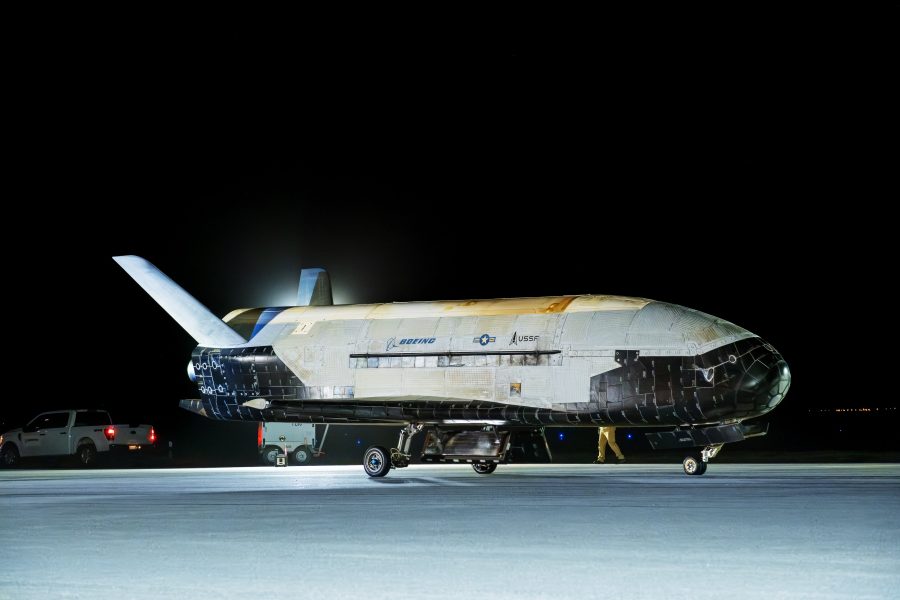The X-37B spaceplane is heading back into orbit for its eighth mission next month, the Space Force announced July 28. Its latest flight will experiment with technologies that may prove crucial to the service’s future.
The unmanned X-37 will launch on a SpaceX Falcon 9 rocket from Kennedy Space Center, Fla., on Aug. 21, per a service release. The Air Force Rapid Capabilities Office, the Air Force Research Laboratory, and the Defense Innovation Unit are involved in the mission as well.
While many of the payloads and technologies on the secretive X-37 are classified, the Space Force did reveal two experiments that will hitch a ride on the upcoming flight.
For one, the X-37 will conduct “laser communications demonstrations involving proliferated commercial satellite networks in low-Earth orbit,” according to the release. Most prominently, SpaceX’s Starlink satellites are equipped with laser communications terminals, though other firms like OneWeb and Telesat are also developing spacecraft with the same technology.
Laser comms offer significant advantages over traditional radio frequencies by transferring more data faster, using less power, needing smaller equipment, and providing more secure signals. But they are also difficult to operate reliably: satellites in low-Earth orbit move 17,000 miles per hour, so they must find each other within a small window of time, point their lasers, and maintain that link for data to go through. Mechanical vibrations can throw off the beam, as can atmospheric conditions during transmissions from space to users down on Earth.
USSF’s Space Development Agency, which is also developing its own constellation in LEO that will use laser communications, has conducted a handful of tests between satellites and established crosslinks. But it has yet to fully operationalize the capability, and the watchdog Government Accountability Office has critiqued the agency’s plan to buy hundreds of satellites for the constellation before fully proving out the technology.
The X-37B’s experiments could help allay those concerns and help the Space Force feel more confident that it can tap into commercial networks, too.
The only other publicly disclosed experiment for X-37B on this flight is a quantum inertial sensor. The Defense Innovation Unit, the Pentagon’s Silicon Valley hub, has looked into quantum sensors as an alternative to the Global Positioning System, which faces increasingly intense jamming and spoofing that could have disastrous consequences for civilian and military users alike.
Because the Earth’s magnetic and gravitational fields vary minutely from place to place and because those variations have already been mapped, a quantum sensor can accurately tell a system’s location by measuring the difference between subatomic particles—and with no need for an external signal, it can’t be jammed.
Like laser communications, though, there are complications. Quantum sensors are extremely sensitive, so creating a device that can perform outside the laboratory is a challenge.
Officials are interested, however, because of growing concerns that the U.S. military is over-reliant on GPS for position, navigation, and timing, and that those signals can be disrupted in times of conflict.
In a post to social media, Chief of Space Operations Gen. B. Chance Saltzman said the X-37 mission is “about making our joint force more connected, more resilient, and ready to operate in the face of any challenge.”
The new launch date comes a little less than six months after X-37 completed its seventh mission, touching down at Vandenberg Space Force Base, Calif. in March. For all but its first mission, the spaceplane has spent more than 400 days in orbit testing new technologies and payloads—suggesting its eighth mission will extend into fall 2026, at least.
An eighth flight of the X-37 wasn’t always guaranteed. In 2020, while still a three-star general, Saltzman suggested that the spaceplane might exemplify “technology that has served its purpose and [maybe] it’s time to start looking at the next available capability.” But by 2023, he had become convinced that “if we have a capability, the idea of creating a gap in that capability is a concern” to national security leaders. Officials are hesitant to back away from a capability without a replacement.
Congress funneled $1 billion to the X-37B program as part of the reconciliation package passed earlier this month. It’s unclear how that money will be spent.


